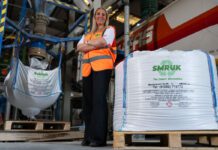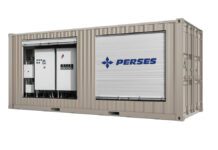
The new £15 million water-themed adventure centre which opened at Dolgarrog in North Wales earlier this year – featuring the world’s first ever purpose-built surfing lake as its signature attraction – was completed with the help of engineering and environmental consultancy Wardell Armstrong, which acted as the civil, environmental and structural engineers for the planning and design stages of the ground-breaking project.
The “Wavegarden” technology that powers the artificial wave facility was developed by Instant Sport S.L in San Sebastian, northern Spain. A snowplough-shaped underwater foil running continuously from one end of the lake to the other generates a consistent wave of up to two metres in height every 60 seconds, breaking in the same place every time with an average power of 270 kW.
The perfectly formed tubing waves can continuously peel without losing their power or shape. Smaller waves of 1.2m and 0.7m can also be created as the first large wave breaks down and is then kicked up again – allowing advanced, intermediate and novice surfers all to be perfecting their technique at the same time in different parts of the 300m long lagoon.
“Surfers around the world routinely have to wait for the right wave conditions which may or may not come,” said Tim Cawood, associate director for Wardell Armstrong. “It’s been known for major surfing championships to be cancelled because of flat seas. It’s been really exciting to be involved in helping to create the first commercial manmade lake in the world with waves that surfers know they can rely on. Even more excitingly, the Surf Snowdonia project is now helping the International Olympic Committee to see surfing as a viable Olympic sport.”
Brownfield remediation
Before the site could open, however, it had to be completely transformed from a derelict brownfield area. Wardell Armstrong was commissioned to carry out the extensive site investigation, geotechnical and environmental engineering work needed for its full regeneration.
Wardell Armstrong was heavily involved as part of the design team up until planning permission was unanimously approved in August 2014 by the planning committee of Conwy Borough Council, and was instrumental in gaining very rapid sign-off of planning conditions relating to ground engineering and the environmental legacy left by 100 years of use as an aluminium factory.
The consultancy designed and managed the site investigation works before carrying out detailed geotechnical assessments to allow the development foundations and earthworks to be designed. The groundwater conditions at the site were particularly challenging and complex, being shallow and influenced by tides and the adjacent hydroelectric plant.
Groundwater monitoring
Wardell Armstrong engineers carried out more than a year of continuous groundwater monitoring using a network of dataloggers to accurately characterise and model risks to the environment and to the proposed development. This culminated in a detailed quantitative risk assessment which set out the clean-up requirements for the site, which were subsequently approved by Natural Resources Wales.
“The building and development of the former factory site was probably the biggest challenge because of a century of contamination beneath the ground,” said MD of Surf Snowdonia Steve Davies. “It took a hell of a lot of work to decontaminate.” Eighteen tanker loads of heavy metals and hydrocarbons were removed, and 25,000 m³ of rubble from the old foundations were crushed and reused.
With the remediation and regeneration work complete, Surf Snowdonia is now an authentic surfing experience in the setting of a fun-filled water-themed adventure centre that should appeal to families, beginners and experts – attracting up to 70,000 visitors a year and creating a hundred new jobs.






